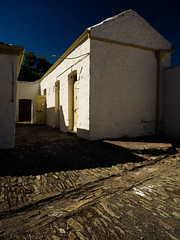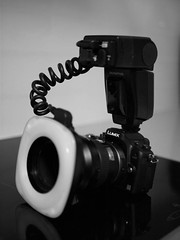Following my last post, many people seemed to be confused over what should be a relatively simple concept – what happens when you place a 400mm lens (in true focal length) on either a full frame 35mm dSLR vs a 2x cropped sensor such as an Olympus or Panasonic dSLR.
First, what does not change significantly or at all:
- perspective at the same subject distance
- if you focus on a subject at a given distance with a lens of the same focal length, then, the size of background objects will be the same in comparison to the subject size
- HOWEVER, if because of a 2x cropped sensor which effectively magnifies your subject 2x, you choose to move away from the subject to keep the subject the same size in the viewfinder as on the full frame, then changing subject distance WILL CHANGE PERSPECTIVE.
- depth of field at same aperture and subject distance
- actually depth of field may actually be reduced if the final image is printed to the same size from each camera and viewed at from the same distance, as DOF is dependent also on the final viewed image magnification – the greater the magnification, the more evident the out of focus areas appear as out of focus
- HOWEVER, if because of a 2x cropped sensor which effectively magnifies your subject 2x, you choose to move away from the subject to keep the subject the same size in the viewfinder as on the full frame, then changing subject distance WILL INCREASE DEPTH OF FIELD which can be a good thing when using super telephoto reach – a big advantage for 2x cropped sensors (not so good for short focal length situations where you wish to blur the background though)
- aperture
Now let’s look at what DOES change substantially:
- image field of view
- how wide a view you see in the viewfinder and in the final print is ONLY dependent on the true focal length and the sensor size (assuming that the design of the lens has an image circle which covers the sensor diagonal)
- angle of view = 2 x arctan[(0.5 x sensor dimension)/true focal length of lens]
- thus, for a 300mm lens, the diagonal angle of view is 8.2 degrees on a full frame and 4.1 degrees on a 2x crop sensor HENCE the term “2x crop”, of course you could use “digital zoom” in post-processing, or in some cameras, within the camera to give a 2x crop image size and thus field of view from a full frame dSLR but thus will have 1/4 of the number of pixels of the full frame image
- subject magnification at the same subject distance – “telephoto reach”
- the comparative size of the subject at the same distance will be twice as much in a 2x crop sensor as on a full frame because of the angle of view issues, but in the final image on screen or in print when enlarged to the same pixels per inch enlargement, the subject size is dependent also on the pixel density of the sensor
- if using sensors with the SAME number of pixels, then subject magnification will be 2x for a 2x cropped sensor, thus giving a substantial advantage to the cropped sensor when telephoto reach is important BUT at a cost of smaller sensor photosites resulting in more image noise at higher ISO and less dynamic range (assuming the same sensor technologies)
- if the full frame sensor had 4x the number of pixels of the 2x cropped sensor, assuming same technology, they will both have the same photosite size, same noise at high ISO and same dynamic range, and if you cropped the full frame image to half its diameter you should give the SAME subject magnification, DOF, perspective as on a 2x crop sensor, BUT what will be different is the optical resolution and aberrations as physics dictates that these will be easier to make to higher specifications on a lens with a smaller image circle (as long as you do not use such a small aperture that the laws of diffraction adversely effect resolution – smaller than f/8 on 2x crop).
- thus even if Canon or Nikon made a 40mp full frame dSLR which would allow telephoto reach magnification of an Olympus 10mp dSLR when cropped and give the option of a full frame image with twice the angle of view, there are unlikely to be any lenses made that could deliver that optical resolution and thus the image will lack the detail of the Olympus image (assuming you are using a ZD lens and not a legacy 35mm lens) – current 35mm zoom lenses struggle to deliver 16mp optical resolution let alone 25mp or 40mp
- perhaps a bigger question would be – can a Canon 5DMII with EF 400mm f/5.6 lens provide the same image detail at the same subject distance as a 12mp Olympus E620/E-30/E-3 with a ZD 50-200mm lens with a 2x TC?
- in my brief experiments, a 10mp Olympus E510 with a ZD 50-200mm lens with a 2x TC EASILY gives more image detail at same subject distance as a Canon 5DMII with EF 70-200mm f/2.8IS L lens with 1.4x TC – presumably this lens combination just can’t give 21mp optical detail.
- hand holdable shutter speed
- traditionally, the slowest shutter speed advisable for hand held work which still provides reasonable image sharpness is dependent primarily on subject magnification which is a proxy for the amount of image movement from camera shake and thus is usually given as 1/(focal length)
- thus, theoretically, you could use 1/400th sec when using a 400mm f/5.6 lens on a Canon 5DMII, although, as you are already pushing the limits of optical resolution when trying for a 21mp image, an even faster shutter speed would be advisable, particularly, given the weight of the lens and the likelihood of muscle fatigue causing increased tremor
- the situation with the Olympus ZD 50-200mm when used on an image stabilised body allows much slower shutter speeds – for instance, with a 2xTC at effective 800mm reach, I usually shoot at 1/200th sec or faster – without the TC, you could shoot at 1/100th sec at 400mm reach. This allows lower ISO to be used for static subjects and helps to negate the main downside of the cropped sensors of image noise at high ISO, although for action shots requiring 1/500-1/1000th sec you may be forced into the higher ISO regions and more noise – although improving technology should address this in the near future.
- lens size and weight
- a lens with an image circle to fit a 2x crop sensor not only can be made to much higher optical resolution and aberration specifications for a given aperture and price point than a 35mm lens, but can be made smaller and lighter and thus more easily hand held and transported which is a major benefit when it comes to super telephotos
- yes, you can get 800mm reach at f/8 on a full frame dSLR, but using a 400mm f/4 lens with 2x TC or a 600mm f/4 with 1.4x TC both options are MUCH bigger, heavier, harder to hold and far more expensive than a ZD 50-200mm f/2.8-3.5 Olympus lens with 2x TC – not to mention the Olympus 2x TC is perhaps the best 2x TC made
Well I hope this clarifies a few things although I am sure many will still debate aspects as always on the net.










